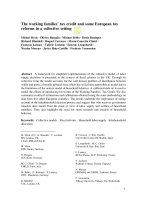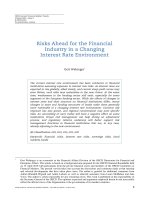The Canadian Economy in a Global Setting pptx
Bạn đang xem bản rút gọn của tài liệu. Xem và tải ngay bản đầy đủ của tài liệu tại đây (826.93 KB, 62 trang )
© 2003 McGraw-Hill Ryerson Limited
The Canadian Economy
The Canadian Economy
in a Global Setting
in a Global Setting
Chapter 3
Chapter 3
© 2003 McGraw-Hill Ryerson Limited.
3 - 2
Laugher Curve
Laugher Curve
Frank: According to this economist,
Ernie, it’s all very simple.
In an endogenous business cycle
where variable-span diffusion
indices are neither rising nor
falling and the capital-to-output
ratio is low, then the interplay of
liquidity preferences and reserve
ratios escalates and interest rates
rise, causing the yield ratio to drop
on common stocks.
© 2003 McGraw-Hill Ryerson Limited.
3 - 3
Laugher Curve
Laugher Curve
Ernie: I get it!
In other words, when the
economy goes higgledy-piggledy,
the TSE goes blooey!
© 2003 McGraw-Hill Ryerson Limited.
3 - 4
The Canadian Economy
The Canadian Economy
Ultimately the Canadian economy’s
strength is its people and its other
resources.
The Canadian economy is far from
perfect.
© 2003 McGraw-Hill Ryerson Limited.
3 - 5
Diagram of a Market
Diagram of a Market
Economy
Economy
The Canadian economy, as most
market economies, is divided into three
groups: business, households, and
government.
© 2003 McGraw-Hill Ryerson Limited.
3 - 6
Diagram of a Market
Diagram of a Market
Economy
Economy
Households supply factors of production
to business and are paid by business
for doing so. The place where this takes
place is called the factor market.
© 2003 McGraw-Hill Ryerson Limited.
3 - 7
Diagram of a Market
Diagram of a Market
Economy
Economy
Business produces goods and services
and sells them to households and
government. The place where this takes
place is called the goods market.
© 2003 McGraw-Hill Ryerson Limited.
3 - 8
Diagram of a Market
Diagram of a Market
Economy
Economy
Government engages in the following
activities:
It buys goods and services from business
and buys labour services from households.
It provides services to both business and
households.
© 2003 McGraw-Hill Ryerson Limited.
3 - 9
Diagram of a Market
Diagram of a Market
Economy
Economy
Government engages in the following
activities:
It gives some of its tax revenues directly back to
individuals (income redistribution).
It oversees the interaction of business and
households in the goods and factor markets.
© 2003 McGraw-Hill Ryerson Limited.
3 - 10
Diagram of a Market
Diagram of a Market
Economy,
Economy,
Fig. 3-1, p 56
Fig. 3-1, p 56
© 2003 McGraw-Hill Ryerson Limited.
3 - 11
Business
Business
Business is the name given to private
producing units in our society.
Businesses decide what to produce, how
much to produce, and for whom to
produce it.
© 2003 McGraw-Hill Ryerson Limited.
3 - 12
Entrepreneurship and
Entrepreneurship and
Business
Business
Entrepreneurship is the ability to
organize and get something done.
It is an important part of business, and
an important ingredient in the economy.
© 2003 McGraw-Hill Ryerson Limited.
3 - 13
Consumer Sovereignty and
Consumer Sovereignty and
Business
Business
Although businesses decide what to
produce, they are guided by consumer
sovereignty.
Consumer sovereignty means that
consumers’ wishes rule what is
produced by businesses.
© 2003 McGraw-Hill Ryerson Limited.
3 - 14
Consumer Sovereignty and
Consumer Sovereignty and
Business
Business
Before deciding to start a business, the
key question is: "Can I make a profit?"
Profit is what’s left over from total revenues after
all the appropriate costs have been subtracted.
© 2003 McGraw-Hill Ryerson Limited.
3 - 15
Consumer Sovereignty and
Consumer Sovereignty and
Business
Business
By channeling the desire to make a
profit for the general good of society,
the Canadian economic system allows
the invisible hand to work.
© 2003 McGraw-Hill Ryerson Limited.
3 - 16
Forms of Business
Forms of Business
There are three major types of
businesses:
sole proprietorships
partnerships
corporations.
© 2003 McGraw-Hill Ryerson Limited.
3 - 17
Sole Proprietorship
Sole Proprietorship
Businesses that have only one owner.
Advantages:
Minimum bureaucratic hassle.
Direct control by owner.
Disadvantages:
Limited ability to get funds.
Unlimited personal liability.
© 2003 McGraw-Hill Ryerson Limited.
3 - 18
Partnership
Partnership
Businesses with two or more owners.
Advantages:
Ability to share work and risks.
Relatively easy to form.
Disadvantages:
Unlimited personal liability (even for
partner's blunder).
Limited ability to get funds.
© 2003 McGraw-Hill Ryerson Limited.
3 - 19
Corporation
Corporation
Businesses that are treated as a person
and are legally owned by their
stockholders who are not liable for the
actions of the corporate "person."
© 2003 McGraw-Hill Ryerson Limited.
3 - 20
Corporation
Corporation
Advantages:
No personal liability.
Increasing ability to get funds.
Ability to shed personal income and gain added expenses.
© 2003 McGraw-Hill Ryerson Limited.
3 - 21
Corporation
Corporation
Disadvantages:
Legal hassle to organize.
Possible double taxation of income.
Monitoring problems.
© 2003 McGraw-Hill Ryerson Limited.
3 - 22
Finance and Business
Finance and Business
The dynamic stock market allows initial
public offerings (IPOs) to quickly
change value and to make their owners
rich (or poor).
E-commerce and the digital economy
are very important, as they add
competitive pressure to the “traditional”
economy
© 2003 McGraw-Hill Ryerson Limited.
3 - 23
Households
Households
Households are a single person or
groups of persons living together and
making joint decisions.
© 2003 McGraw-Hill Ryerson Limited.
3 - 24
The Power of Households
The Power of Households
Households influence the other two
economic institutions – government and
business.
© 2003 McGraw-Hill Ryerson Limited.
3 - 25
Households as Suppliers of
Households as Suppliers of
Labour
Labour
The largest source of household income
is wages and salaries.
Households supply the labour with
which businesses produce and
government governs.









